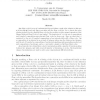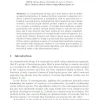158 search results - page 6 / 32 » Some counting problems related to permutation groups |
IPL
2011
13 years 2 months ago
2011
Any Gray code for a set of combinatorial objects defines a total order relation on this set: x is less than y if and only if y occurs after x in the Gray code list. Let ≺ denot...
JCO
2010
13 years 6 months ago
2010
We study the extremal parameter N(n, m, H) which is the largest number of copies of a hypergraph H that can be formed of at most n vertices and m edges. Generalizing previous work...
COCOON
2005
Springer
14 years 1 months ago
2005
Springer
In computational biology, gene order data is often modelled as signed permutations. A classical problem in genome comparison is to detect conserved segments in a permutation, that ...
ICASSP
2011
IEEE
12 years 11 months ago
2011
IEEE
This paper presents a novel method for solving the permutation problem inherent to frequency domain blind signal separation of multiple simultaneous speakers. As conventional meth...
ALGOSENSORS
2008
Springer
13 years 9 months ago
2008
Springer
We consider the problem of counting a set of discrete point targets using a network of sensors under a minimalistic model. Each sensor outputs a single integer, the number of disti...


